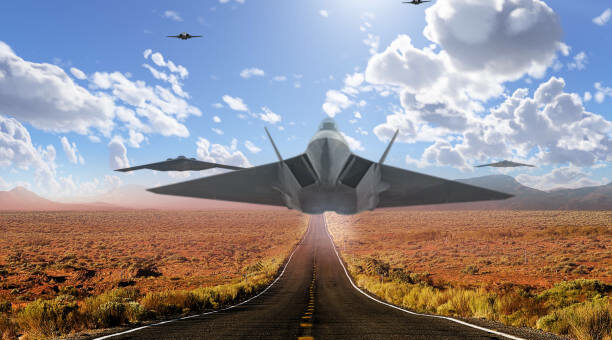
Introduction: Breaking the Sound Barrier
Supersonic military jets have captured the imagination of engineers, pilots, and aviation enthusiasts alike. Flying faster than the speed of sound requires precise engineering and a deep understanding of aerodynamics, propulsion, and materials science. The speed threshold where aircraft surpass the speed of sound is referred to as Mach 1, which is approximately 767 mph (1,235 km/h) at sea level. Jets that travel at or beyond this speed are considered supersonic.
The purpose of supersonic military jets extends far beyond speed. These aircraft are designed for rapid deployment, interception, reconnaissance, and even nuclear strike capabilities. Understanding the science behind them provides insight into how advanced nations maintain air superiority and project power globally.
1. Understanding Supersonic Flight
1.1 The Basics of Mach Numbers
Supersonic speeds are measured in Mach numbers, a ratio of the object’s speed to the speed of sound in air.
Speed Classifications:
- Subsonic: Below Mach 0.8
- Transonic: Mach 0.8 to 1.2
- Supersonic: Mach 1.2 to 5
- Hypersonic: Above Mach 5
A jet flying at Mach 2 is traveling twice the speed of sound. The exact Mach number depends on atmospheric pressure and temperature.
Key Considerations:
- As speed increases, drag and heat resistance rise exponentially.
- Supersonic jets must overcome shock waves and sonic booms.
1.2 Shock Waves and Sonic Booms
When an aircraft surpasses the speed of sound, air molecules can’t move out of the way quickly enough, resulting in shock waves. These waves form conical pressure fronts that trail the aircraft.
Effects of Supersonic Speed:
- Formation of shock waves
- Sonic booms experienced on the ground
- Increased aerodynamic stress on the airframe
Designers must account for these forces to prevent structural failure and ensure pilot safety.
2. Aerodynamics of Supersonic Jets
2.1 Streamlined Design
Supersonic jets feature highly streamlined bodies to minimize drag and withstand high-speed airflow. The airframe must reduce pressure drag while maximizing lift.
Common Features:
- Narrow fuselages
- Delta or swept wings
- Sharp nose cones
- Area ruling (waist narrowing)
Example: The SR-71 Blackbird’s fuselage narrows along the body to maintain smooth supersonic airflow, exemplifying area rule application.
2.2 Control Surfaces and Stability
Controlling an aircraft at supersonic speeds presents unique challenges. Traditional control surfaces like ailerons and rudders can become less effective.
Solutions Include:
- All-moving tailplanes (stabilators)
- Canards for enhanced pitch control
- Fly-by-wire systems for stability management
Modern jets use advanced computer systems to help pilots maintain control at extreme velocities.
3. Supersonic Propulsion Technologies
3.1 Turbojet and Afterburner Systems
Supersonic jets use powerful engines designed to function efficiently at high speeds. The most common engine types are turbojets and low-bypass turbofans with afterburners.
Engine Characteristics:
- High thrust-to-weight ratios
- Afterburners inject fuel post-combustion to produce extra thrust
- Variable-geometry inlets to optimize airflow
Example: The F-15 Eagle uses Pratt & Whitney F100 engines capable of Mach 2.5 with afterburners engaged.
3.2 Ramjets and Scramjets
Advanced propulsion systems are being tested for hypersonic applications. Ramjets and scramjets operate without moving parts, relying on the aircraft’s speed to compress incoming air.
Comparison Table:
| Engine Type | Speed Range | Efficiency (Mach) | Application |
|---|---|---|---|
| Turbojet | Subsonic–Supersonic | Mach 1–2.5 | Most current fighters |
| Ramjet | Supersonic | Mach 3–6 | Missiles |
| Scramjet | Hypersonic | Mach 6+ | Experimental aircraft |
4. Materials and Thermal Management
4.1 High-Temperature Materials
Flying at supersonic speeds causes significant heating due to air friction. Aircraft must be made from materials that can withstand temperatures exceeding 500°F (260°C).
Materials Used:
- Titanium alloys (e.g., used in SR-71)
- High-temperature composites
- Advanced ceramics
These materials ensure structural integrity and reduce weight.
4.2 Thermal Protection Systems
To further manage heat, supersonic jets use passive and active cooling mechanisms.
Thermal Solutions Include:
- Heat-dissipating skin coatings
- Coolant channels within engine bays
- Thermal expansion design considerations
Example: The SR-71’s body would expand significantly during flight, requiring special design tolerances and flexible fuel tanks.
5. Avionics and Pilot Experience at Supersonic Speeds
5.1 Supersonic Cockpit Interfaces
Flying at supersonic speeds demands rapid decision-making. Pilots rely on advanced avionics for navigation, targeting, and system monitoring.
Avionics Capabilities:
- Heads-up displays (HUDs)
- Helmet-mounted displays
- Real-time data links and radar
These systems reduce cognitive load and provide situational awareness.
5.2 Pilot Training and G-Force Endurance
Supersonic flight exerts immense pressure on the human body. Pilots undergo rigorous training and wear specialized gear.
Support Systems:
- G-suits to prevent blood pooling
- Oxygen masks and pressurized cabins
- Ejection seats rated for high-speed deployment
Example: Pilots of the MiG-31 Foxhound train for long-duration supersonic patrols across vast territories.
6. Operational Use and Strategic Impact
6.1 Mission Profiles of Supersonic Jets
Supersonic jets fulfill various roles beyond simple speed.
Mission Types:
- Interceptor missions (e.g., MiG-25, F-104)
- Tactical bombing (e.g., F-111 Aardvark)
- Reconnaissance (e.g., SR-71)
Speed allows jets to penetrate enemy airspace quickly and escape before interception.
6.2 Limitations and Cost Considerations
Despite their power, supersonic jets come with drawbacks.
Challenges:
- High operational and maintenance costs
- Fuel inefficiency at lower speeds
- Noise pollution from sonic booms
Example: The Concorde’s commercial demise was partly due to high costs and restricted flight paths—lessons applicable to military contexts.
Conclusion: Speed as a Strategic Advantage
Supersonic military jets represent the pinnacle of aerospace engineering. Their ability to fly faster than sound, engage enemies quickly, and execute strategic missions gives military forces a distinct advantage. However, that speed comes with engineering complexity, high costs, and physical demands on both pilots and airframes.
Key Takeaways:
- Supersonic jets rely on precise aerodynamics and specialized propulsion
- Advanced materials and cooling systems are crucial
- Pilots need extensive training and high-tech support systems